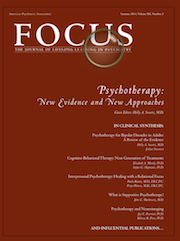The Efficacy of Cognitive-Behavioral Therapy and Psychodynamic Therapy in the Outpatient Treatment of Major Depression: A Randomized Clinical Trial
Abstract
Objective
The efficacy of psychodynamic therapies for depression remains open to debate because of a paucity of high-quality studies. The authors compared the efficacy of psychodynamic therapy with that of cognitive-behavioral therapy (CBT), hypothesizing nonsignificant differences and the noninferiority of psychodynamic therapy relative to CBT.
Method
A total of 341 adults who met DSM-IV criteria for a major depressive episode and had Hamilton Depression Rating Scale (HAM-D) scores ≥14 were randomly assigned to 16 sessions of individual manualized CBT or short-term psychodynamic supportive therapy. Severely depressed patients (HAM-D score >24) also received antidepressant medication according to protocol. The primary outcome measure was posttreatment remission rate (HAM-D score ≤7). Secondary outcome measures included mean posttreatment HAM-D score and patient-rated depression score and 1-year follow-up outcomes. Data were analyzed with generalized estimating equations and mixed-model analyses using intent-to-treat samples. Noninferiority margins were prespecified as an odds ratio of 0.49 for remission rates and a Cohen’s d value of 0.30 for continuous outcome measures.
Results
No statistically significant treatment differences were found for any of the outcome measures. The average posttreatment remission rate was 22.7%. Noninferiority was shown for posttreatment HAM-D and patient-rated depression scores but could not be demonstrated for posttreatment remission rates or any of the follow-up measures.
Conclusions
The findings extend the evidence base of psychodynamic therapy for depression but also indicate that time-limited treatment is insufficient for a substantial number of patients encountered in psychiatric outpatient clinics.
(Reprinted with permission from the American Journal of Psychiatry 2013; 170:1041–1050)



